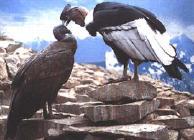

Genus: Vultur
Species: gryphus

I have never liked vultures. Not too many people do. After reading about them, however, I have changed my mind. Condors mate for life, they both take care of their chick, they don't kill animals, only eat their remains, and they look the way they do for very specialized reasons.
The condor is the largest vulture in South America. It has a wing span of up to 10 feet and more. Male condors can weigh 24 to 33 pounds, and females from 18 to 24 pounds. It has mostly black feathers, with white flight feathers on its wing. Head feathers would get dirty when they ate, so their heads and necks are naked like most vultures. The skin on the head and throat hang in lose folds, and is reddish-black, with a fleshy wattle over the beak, called a caruncle. Condors can soar to altitudes of 18,000 feet, and to keep their heads warm at that height they tuck them into a downy, white neck ruff.
Condors can live up to 50 years, and mate for life. The female will lay her egg on a cliff ledge. Because there aren't any trees or other materials to build a nest with where they live they lay their egg on bare rock. Both parents take turns incubating the egg. They have one chick every other year. Their young take a lot of time and effort to raised. They can't fly until they are 6 months old and then rely on their parents for two more years.
Andean condors roost on the face of a cliff, and use the thermal updraft of warm morning air to lift off. They spend most of the day soaring on the updrafts created by the mountains and valleys. They cover a large area while foraging. Andean condors can be found over the coasts of Peru and Chile, and the Patagonian steppe of Argentina. They can spot a carcass from several miles off. Usually they follow smaller scavenger birds to find a carcass. This helps both scavengers, because only the condor can tear through the tough hides of some carcasses. The older condors get to eat first, and then the younger ones take turns in order of age. Condors feed mostly on the remains of mammals such as sheep, llama, vicuña, cattle, seals and the eggs of seabirds. Sometimes they will take newborn animals.
The Andean condor has a long life, but breeds very slowly. It takes them 6 to 8 years before they become mature. Any interference from humans quickly disturbs their pattern of breeding. Hunters kill the condor for sport, and farmers kill them because they think condors kill their animals. Because they mate for life, the death of a mate is very hard on the other partner and their chick. Condors have also died recently from pesticides that have been carried through the food chains. The number of Andean condors has gone down rapidly in recent years, but they still aren't on the official endangered list. Rescue attempts have been made through breeding captive condors and habitat research. These efforts have been moderately successful.
Bibliography:
"Andean Condor", Wildlife Explorer. USA: International Masters Publishers. 1998
" The Hawk Conservancy - Andean Condor", http://www.hawk-conservancy.org/priors/george.htm